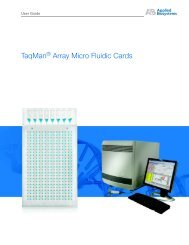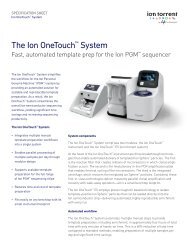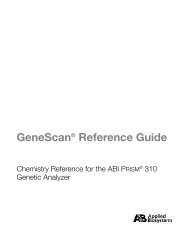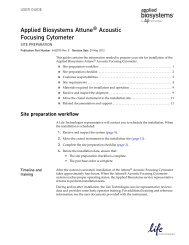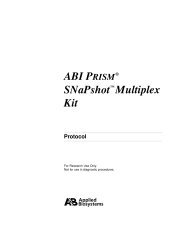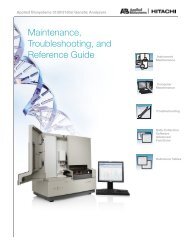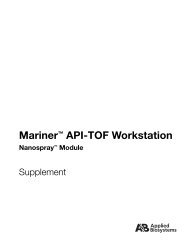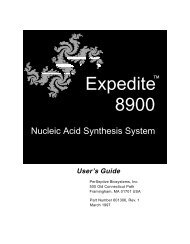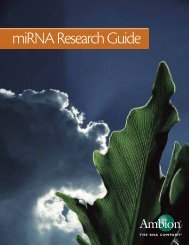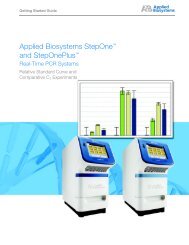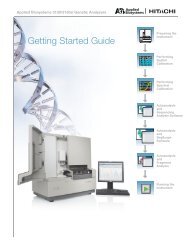Applied Biosystems SOLiD™ 4 System SETS Software User Guide ...
Applied Biosystems SOLiD™ 4 System SETS Software User Guide ...
Applied Biosystems SOLiD™ 4 System SETS Software User Guide ...
You also want an ePaper? Increase the reach of your titles
YUMPU automatically turns print PDFs into web optimized ePapers that Google loves.
Parameter Description<br />
<strong>Applied</strong> <strong>Biosystems</strong> SOLiD 4 <strong>System</strong> <strong>SETS</strong> <strong>Software</strong> <strong>User</strong> <strong>Guide</strong><br />
Chapter 2 Prepare Run Settings<br />
Set analysis parameters 2<br />
HQ Beads When visualizing the beads on a satay plot, those that are on the axis and far<br />
from the origin are the beads that have a bright signal in only one channel.<br />
High quality beads are a summary of the “good” and “best” beads that are<br />
reported in the Cycle Scans Report (available in both ICS and <strong>SETS</strong>).<br />
There are two concept definitions necessary: intensity and angle.<br />
The concept of intensity is defined as the magnitude of the scaled intensity<br />
vector;<br />
The concept of angle is defined as 1 - cos(theta), where theta is the angle (in<br />
four-dimensional scaled intensity space) between the bead intensity vector<br />
and the axis of the called color.<br />
The intensity value can increase due to the total intensity across all channels<br />
independent of the intensity of the primary channel alone.<br />
Considering the angle and the intensity, a “good” bead is a usable bead that<br />
satisfies the following conditions:<br />
intensity >0.05<br />
0.0125 < angle ≤0.05<br />
A “best” bead is a usable bead that satisfies these conditions:<br />
intensity >0.05<br />
angle ≤0.0125<br />
A “best” bead is not a “good” bead because these are exclusive classes.<br />
The set of high quality beads, for this metric, is the merging of the two<br />
classes.<br />
These values are also highly correlated to the quality values (QV) for calls. A<br />
drop in the percentage of beads falling into the HQ category indicates that an<br />
accurate color calling is becoming more difficult.<br />
Bead Retention The number of usable beads in the analysis of a panel for any particular<br />
ligation cycle is nearly always smaller than the total number of beads found in<br />
the corresponding focal map image.<br />
Bead retention is simply the fraction of the total number of beads that are<br />
usable.<br />
Because the stage can drift slightly from one slide scan to the next, beads<br />
near the edges of a panel might not be imaged in all four colors.<br />
The software will call a color only for bead locations that are imaged in all four<br />
color-scans of a ligation cycle (i.e. any usable bead).<br />
Since beads are identified, or found, only during the focal map analysis stage,<br />
a call is made for such a bead location, even if the bead has physically moved<br />
from that position. In such cases, since the bead location is most likely now<br />
vacant, subsequent color calls will be based on data dominated by noise or, if<br />
present, a close neighbor bead. As such beads are still classified as usable,<br />
bead retention is not sensitive to such dislocations.<br />
27



